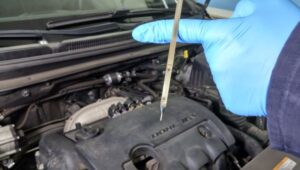Engine oil check
Engine oil is required for its mechanical components to be lubricated and to function properly during operation.
Low oil levels can cause extensive damage to the engine bearings and crankshaft. When the level is too low, the oil pump cannot deliver the required amount of lubricating oil, there is an increase in friction, heating, and damage to the bearings.
When the oil level is too high the crankshaft touches the oil during operation, creating a foam so that the bearings instead of oil receive air, resulting in insufficient lubrication and damage to the engine components. Regular checks of the engine oil level can prevent such problems.
Besides oil level, quality such as colour, density, mixing of liquids, and odour change is controlled. The engine oil level and quality should be checked periodically, usually at each or at least every second arrival at the pump. If any irregularity is observed during the examination, a more thorough examination should be done immediately to identify and remedy the cause.








